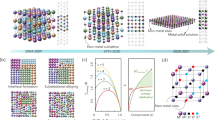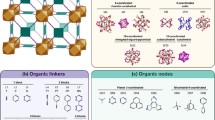Abstract
Although large efforts have been dedicated to studying two-dimensional materials for catalysis, a rationalization of the associated trends in their intrinsic activity has so far been elusive. In the present work we employ density functional theory to examine a variety of two-dimensional materials, including, carbon based materials, hexagonal boron nitride (h-BN), transition metal dichalcogenides (e.g. MoS2, MoSe2) and layered oxides, to give an overview of the trends in adsorption energies. By examining key reaction intermediates relevant to the oxygen reduction, and oxygen evolution reactions we find that binding energies largely follow the linear scaling relationships observed for pure metals. This observation is very important as it suggests that the same simplifying assumptions made to correlate descriptors with reaction rates in transition metal catalysts are also valid for the studied two-dimensional materials. By means of these scaling relations, for each reaction we also identify several promising candidates that are predicted to exhibit a comparable activity to the state-of-the-art catalysts.
Graphical Abstract
Scaling relationship for the chemisorption energies of OH* and OOH* on various 2D materials.


Similar content being viewed by others
References
Geim AK, Novoselov KS (2007) The rise of graphene. Nat Mater 6:183–191. doi:10.1038/nmat1849
Geim AK (2009) Graphene: status and prospects. Science 324:1530–1534. doi:10.1126/science.1158877
Neto AHC, Novoselov K (2011) New directions in science and technology: two-dimensional crystals. Rep Prog Phys 74:082501. doi:10.1088/0034-4885/74/8/082501
Bonaccorso F, Sun Z, Hasan T, Ferrari AC (2010) Graphene photonics and optoelectronics. Nat Photonics 4:611–622. doi:10.1038/nphoton.2010.186
Sun Y, Wu Q, Shi G (2011) Graphene based new energy materials. Energy Environ Sci 4:1113. doi:10.1039/c0ee00683a
Brownson DAC, Kampouris DK, Banks CE (2011) An overview of graphene in energy production and storage applications. J Power Sources 196:4873–4885. doi:10.1016/j.jpowsour.2011.02.022
Pumera M (2011) Graphene-based nanomaterials for energy storage. Energy Environ Sci 4:668–674. doi:10.1039/C0EE00295J
Gupta A, Sakthivel T, Seal S (2015) Recent development in 2D materials beyond graphene. Prog Mater Sci 73:44–126. doi:10.1016/j.pmatsci.2015.02.002
Koski KJ, Cui Y (2013) The new skinny in two-dimensional nanomaterials. ACS Nano 7:3739–3743. doi:10.1021/nn4022422
Chhowalla M, Shin HS, Eda G et al (2013) The chemistry of two-dimensional layered transition metal dichalcogenide nanosheets. Nat Chem 5:263–275. doi:10.1038/nchem.1589
Das S, Robinson JA, Dubey M et al (2015) Beyond graphene: progress in novel two-dimensional materials and van der Waals solids. Annu Rev Mater Res 45:1–27. doi:10.1146/annurev-matsci-070214-021034
Kim SJ, Choi K, Lee B et al (2015) Materials for flexible, stretchable electronics: graphene and 2D materials. Annu Rev Mater Res 45:63–84. doi:10.1146/annurev-matsci-070214-020901
Lotsch BV (2015) Vertical 2D heterostructures. Annu Rev Mater Res 45:85–109. doi:10.1146/annurev-matsci-070214-020934
Butler SZ, Hollen SM, Cao L et al (2013) Progress, challenges, and opportunities in two-dimensional materials beyond graphene. ACS Nano 7:2898–2926. doi:10.1021/nn400280c
Lee C, Wei X, Kysar JW, Hone J (2008) Measurement of the elastic properties and intrinsic strength of monolayer graphene. Science 321:385–388. doi:10.1126/science.1157996
Novoselov KS, Geim AK, Morozov SV et al (2004) Electric field effect in atomically thin carbon films. Science 306:666–669. doi:10.1126/science.1102896
Balandin AA, Ghosh S, Bao W et al (2008) Superior thermal conductivity of single-layer graphene. Nano Lett 8:902–907. doi:10.1021/nl0731872
Kong D, Wang H, Cha JJ et al (2013) Synthesis of MoS2 and MoSe2 films with vertically aligned layers. Nano Lett 13:1341–1347. doi:10.1021/nl400258t
Dai L (2013) Functionalization of graphene for efficient energy conversion and storage. Acc Chem Res 46:31–42. doi:10.1021/ar300122m
Wang H, Yuan X, Zeng G et al (2015) Three dimensional graphene based materials: Synthesis and applications from energy storage and conversion to electrochemical sensor and environmental remediation. Adv Colloid Interface Sci 221:41–59. doi:10.1016/j.cis.2015.04.005
Liu J, Song P, Ning Z, Xu W (2015) Recent advances in heteroatom-doped metal-free electrocatalysts for highly efficient oxygen reduction reaction. Electrocatalysis 6:132–147. doi:10.1007/s12678-014-0243-9
Wong WY, Daud WRW, Mohamad AB et al (2013) Recent progress in nitrogen-doped carbon and its composites as electrocatalysts for fuel cell applications. Int J Hydrog Energy 38:9370–9386. doi:10.1016/j.ijhydene.2012.12.095
Terrones H, Lv R, Terrones M, Dresselhaus MS (2012) The role of defects and doping in 2D graphene sheets and 1D nanoribbons. Rep Prog Phys 75:062501. doi:10.1088/0034-4885/75/6/062501
Uosaki K, Elumalai G, Noguchi H et al (2014) Boron nitride nanosheet on gold as an electrocatalyst for oxygen reduction reaction: theoretical suggestion and experimental proof. J Am Chem Soc 136:6542–6545. doi:10.1021/ja500393g
Koitz R, Nørskov JK, Studt F (2015) A systematic study of metal-supported boron nitride materials for the oxygen reduction reaction. Phys Chem Chem Phys 17:12722–12727. doi:10.1039/c5cp01384d
Feng L, Liu Y, Zhao J (2015) Iron-embedded boron nitride nanosheet as a promising electrocatalyst for the oxygen reduction reaction (ORR): a density functional theory (DFT) study. J Power Sources 287:431–438. doi:10.1016/j.jpowsour.2015.04.094
Ouyang W, Zeng D, Yu X et al (2014) Exploring the active sites of nitrogen-doped graphene as catalysts for the oxygen reduction reaction. Int J Hydrog Energy 39:15996–16005. doi:10.1016/j.ijhydene.2014.01.045
Qu L, Liu Y, Baek J-B, Dai L (2010) Nitrogen-doped graphene as efficient metal-free electrocatalyst for oxygen reduction in fuel cells. ACS Nano 4:1321–1326. doi:10.1021/nn901850u
Gong K, Du F, Xia Z et al (2009) Nitrogen-doped carbon nanotube arrays with high electrocatalytic activity for oxygen reduction. Science 323:760–764. doi:10.1126/science.1168049
Wang L, Yin F, Yao C (2014) N-doped graphene as a bifunctional electrocatalyst for oxygen reduction and oxygen evolution reactions in an alkaline electrolyte. Int J Hydrog Energy 39:15913–15919. doi:10.1016/j.ijhydene.2014.04.071
Li M, Zhang L, Xu Q et al (2014) N-doped graphene as catalysts for oxygen reduction and oxygen evolution reactions: theoretical considerations. J Catal 314:66–72. doi:10.1016/j.jcat.2014.03.011
Zhang J, Zhao Z, Xia Z, Dai L (2015) A metal-free bifunctional electrocatalyst for oxygen reduction and oxygen evolution reactions. Nat Nanotechnol 10:444–452. doi:10.1038/nnano.2015.48
Liang W, Chen J, Liu Y, Chen S (2014) Density-functional-theory calculation analysis of active sites for four-electron reduction of O2 on Fe/N-doped graphene. ACS Catal 4:4170–4177. doi:10.1021/cs501170a
Studt F (2012) The oxygen reduction reaction on nitrogen-doped graphene. Catal Lett 143:58–60. doi:10.1007/s10562-012-0918-x
Fazio G, Ferrighi L, Di Valentin C (2014) Boron-doped graphene as active electrocatalyst for oxygen reduction reaction at a fuel-cell cathode. J Catal 318:203–210. doi:10.1016/j.jcat.2014.07.024
Jiao Y, Zheng Y, Jaroniec M, Qiao SZ (2014) Origin of the electrocatalytic oxygen reduction activity of graphene-based catalysts: a roadmap to achieve the best performance. J Am Chem Soc 136:4394–4403. doi:10.1021/ja500432h
Hinnemann B, Moses PG, Bonde J et al (2005) Biomimetic hydrogen evolution: MoS2 nanoparticles as catalyst for hydrogen evolution. J Am Chem Soc 127:5308–5309. doi:10.1021/ja0504690
Jaramillo TF, Jørgensen KP, Bonde J et al (2007) Identification of active edge sites for electrochemical H2 evolution from MoS2 nanocatalysts. Science 317:100–102. doi:10.1126/science.1141483
Chan K, Tsai C, Hansen HA, Nørskov JK (2014) Molybdenum sulfides and selenides as possible electrocatalysts for CO2 reduction. ChemCatChem 6:1899–1905. doi:10.1002/cctc.201402128
Bollinger MV, Lauritsen JV, Jacobsen KW et al (2001) One-dimensional metallic edge states in MoS2. Phys Rev Lett 87:196803. doi:10.1103/PhysRevLett.87.196803
Tsai C, Chan K, Nørskov JK, Abild-Pedersen F (2015) Rational design of MoS2 catalysts: tuning the structure and activity via transition metal doping. Catal Sci Technol 5:246–253. doi:10.1039/C4CY01162G
Tsai C, Chan K, Nørskov JK, Abild-Pedersen F (2014) Understanding the reactivity of layered transition-metal sulfides: a single electronic descriptor for structure and adsorption. J Phys Chem Lett 5:3884–3889. doi:10.1021/jz5020532
Wang H, Tsai C, Kong D et al (2015) Transition-metal doped edge sites in vertically aligned MoS2 catalysts for enhanced hydrogen evolution. Nano Res 8:566–575. doi:10.1007/s12274-014-0677-7
Friebel D, Louie MW, Bajdich M et al (2015) Identification of highly active Fe sites in (Ni,Fe)OOH for electrocatalytic water splitting. J Am Chem Soc 137:1305–1313. doi:10.1021/ja511559d
Burke MS, Kast MG, Trotochaud L et al (2015) Cobalt-iron (oxy)hydroxide oxygen evolution electrocatalysts: the role of structure and composition on activity, stability, and mechanism. J Am Chem Soc 137:3638–3648. doi:10.1021/jacs.5b00281
Zhang B, Zheng X, Voznyy O et al (2016) Homogeneously dispersed, multimetal oxygen-evolving catalysts. Science. doi:10.1126/science.aaf1525
McCrory CCL, Jung S, Ferrer IM et al (2015) Benchmarking HER and OER electrocatalysts for solar water splitting devices. J Am Chem Soc 137:4347–4357. doi:10.1021/ja510442p
McCrory CCL, Jung S, Peters JC, Jaramillo TF (2013) Benchmarking heterogeneous electrocatalysts for the oxygen evolution reaction. J Am Chem Soc 135:16977–16987. doi:10.1021/ja407115p
Nørskov JK, Rossmeisl J, Logadottir A et al (2004) Origin of the overpotential for oxygen reduction at a fuel-cell cathode. J Phys Chem B 108:17886–17892. doi:10.1021/jp047349j
Rossmeisl J, Qu Z-W, Zhu H et al (2007) Electrolysis of water on oxide surfaces. J Electroanal Chem 607:83–89. doi:10.1016/j.jelechem.2006.11.008
Abild-Pedersen F, Greeley J, Studt F et al (2007) Scaling properties of adsorption energies for hydrogen-containing molecules on transition-metal surfaces. Phys Rev Lett 99:016105. doi:10.1103/PhysRevLett.99.016105
Fernández EM, Moses PG, Toftelund A et al (2008) Scaling relationships for adsorption energies on transition metal oxide, sulfide, and nitride surfaces. Angew Chem Int Ed Engl 47:4683–4686. doi:10.1002/anie.200705739
Greeley J, Stephens IEL, Bondarenko AS et al (2009) Alloys of platinum and early transition metals as oxygen reduction electrocatalysts. Nat Chem 1:552–556. doi:10.1038/nchem.367
Viswanathan V, Hansen HA, Rossmeisl J, Nørskov JK (2012) Universality in oxygen reduction electrocatalysis on metal surfaces. ACS Catal 2:1654–1660. doi:10.1021/cs300227s
Giannozzi P, Baroni S, Bonini N et al (2009) QUANTUM ESPRESSO: a modular and open-source software project for quantum simulations of materials. J Phys Condens Matter 21:395502. doi:10.1088/0953-8984/21/39/395502
Atomic Simulation Environment (ASE) Center for Atomic Scale Material Design (CAMD), Technical University of Denmark, Lyngby. https://wiki.fysik.dtu.dk/ase
Wellendorff J, Lundgaard KT, Møgelhøj A et al (2012) Density functionals for surface science: exchange–correlation model development with Bayesian error estimation. Phys Rev B 85:235149. doi:10.1103/PhysRevB.85.235149
Kresse G (1996) Efficient iterative schemes for ab initio total-energy calculations using a plane-wave basis set. Phys Rev B 54:11169–11186. doi:10.1103/PhysRevB.54.11169
Kresse G, Furthmüller J (1996) Efficiency of ab-initio total energy calculations for metals and semiconductors using a plane-wave basis set. Comput Mater Sci 6:15–50. doi:10.1016/0927-0256(96)00008-0
Dudarev SL, Savrasov SY, Humphreys CJ, Sutton AP (1998) Electron-energy-loss spectra and the structural stability of nickel oxide: an LSDA + U study. Phys Rev B 57:1505–1509. doi:10.1103/PhysRevB.57.1505
Ng JWD, García-Melchor M, Bajdich M et al (2016) Gold-supported cerium-doped NiOx catalysts for water oxidation. Nat Energy 1:16053. doi:10.1038/nenergy.2016.53
Siahrostami S, Vojvodic A (2015) Influence of adsorbed water on the oxygen evolution reaction on oxides. J Phys Chem C 119:1032–1037. doi:10.1021/jp508932x
Koper MTM (2013) Theory of multiple proton–electron transfer reactions and its implications for electrocatalysis. Chem Sci 4:2710. doi:10.1039/c3sc50205h
Man IC, Su H-Y, Calle-Vallejo F et al (2011) Universality in oxygen evolution electrocatalysis on oxide surfaces. ChemCatChem 3:1159–1165. doi:10.1002/cctc.201000397
Acknowledgments
We gratefully acknowledge support from the U.S. Department of Energy, Office of Sciences, Office of Basic Energy Sciences, to the SUNCAT Center for Interface Science and Catalysis. S.S and M.K acknowledge support from the Global Climate Energy Project (GCEP) at Stanford University (Fund No. 52454).
Author information
Authors and Affiliations
Corresponding author
Electronic supplementary material
Below is the link to the electronic supplementary material.
Rights and permissions
About this article
Cite this article
Siahrostami, S., Tsai, C., Karamad, M. et al. Two-Dimensional Materials as Catalysts for Energy Conversion. Catal Lett 146, 1917–1921 (2016). https://doi.org/10.1007/s10562-016-1837-z
Received:
Accepted:
Published:
Issue Date:
DOI: https://doi.org/10.1007/s10562-016-1837-z




